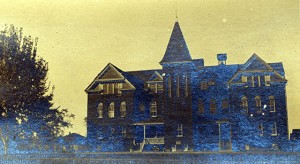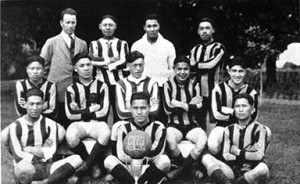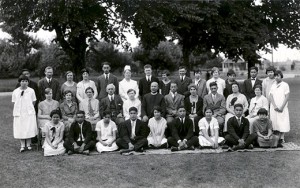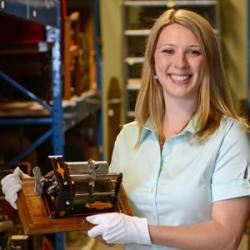
Front view of the first Coqualeetza Indian Residential school building on Vedder Road in Sardis. Chilliwack Archives P8151
In light of the release of the final report of the Truth and Reconciliation Commission, I was reminded of some research that I completed for our recently launched annual exhibition, Game On! The Evolution of Sports in Chilliwack, that never made it into the final cut of the exhibit text. On May 26-28 1931, Coqualeetza Indian Residential School in Sardis hosted the first Canadian Indian Residential Schools Olympiad. It was held at Coqualeetza with events rotating between the 2 other residential schools in the area and covered many aspects of sports; track a
nd field, soccer, basketball, badminton, softball, baseball and shooting. Coqualeetza won the Department of Indian Affairs championship shield, as the point total shows:
- Coqualeetza Indian Residential School, Sardis 170
- St. George’s Indian Residential School, Lytton 73.5
- St. Michael’s Indian Residential School, Alert Bay 59.5
“A thrilling experience was a trip of the boys and girls basketball teams to play against St. George’s School at Lytton. The trip was unique in that we made the first bus trip over the ‘new’ Fraser Canyon Highway, which was just built. The road had numerous curves and in one mountainous stretch we counted twenty-two hairpin turns in a mile. At one point a large fir tree fell directly in front of the bus and had to be cleared away before we could proceed.”
– George Williams, Coqualeetza basketball coach, Chilliwack Archives, AM 456

Group portrait Coqualeetza senior boys football team, winners of the cup in 1925-1926. Chilliwack Archives P4284
The event was meant to be an annual celebration of sport during an era when public recreation was just in its infancy. The health benefits of sports were only recently emerging as an important part of a balanced lifestyle. Athletics at Coqualeetza Indian Residential School were related to vigour and health in the new field of “Physical Education”. It is during this era that BC established the Recreational and Physical Education Branch and the first Provincial Recreation program, a community-oriented scheme called Pro-Rec. The program was aimed at providing healthy recreation opportunities, especially amongst unemployed youths during the Depression – essentially the beginning of organized sports. Pro-Rec came to be the centre piece in provincial adult education programs and served as a model for recreation schemes in other provinces.
While the Indian Residential Schools Olympiad gave students a brief break from the highly regulated way of life that characterized most residential schools, this break was part of an assimilative strategy that was used to discipline their “savage” ways and, in turn, transform them into “normal” Canadian citizens. The policy of Canada’s residential schools was to remove children from the influence of their families and culture, and assimilate them into the dominant Canadian culture.[1] Over the course of the system’s existence, about 30% of Indigenous children, or roughly 150,000, were placed in residential schools nationally. The program was funded by the Canadian government’s Indian Affairs and Northern Development, and administered by Christian churches, predominantly the Roman Catholic Church in Canada (60%), but also the Anglican Church of Canada (30%), and the United Church of Canada (including its pre-1925 constituent church predecessors) (10%).[2]

Group portrait of staff and senior students of Coqualeetza Residential School. Chilliwack Archives P7511
There has long been significant historiographical and popular controversy about the conditions experienced by students in the residential schools. While day schools for First Nations, Métis and Inuit children always far outnumbered residential schools, a new consensus emerged in the early 21st century that the latter schools did significant harm to Aboriginal children who attended them by removing them from their families, depriving them of their ancestral languages, through sterilization, and by exposing many of them to physical leading to sexual abuse by staff members, and other students, and enfranchising them forcibly.
The 1931 Olympiad is a spectacle of physical endurance and strength but also a stark reminder of the often hidden historical wrongs committed in BC communities. My research was never able to uncover whether the Olympiad continued in subsequent years. Records from the Department of Indian Affairs do not show whether the Olympiad was funded in subsequent budgetary cycles. However, there have been numerous “Indian” Olympiads in BC throughout the twentieth century.
[1] Honouring the Truth, Reconciling for the Future. Truth and Reconciliation Commission of Canada. May 2015.
[2] Oblates in the West, accessed at: http://oblatesinthewest.library.ualberta.ca/eng/impact/schools.html


Comments are closed.